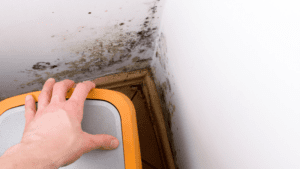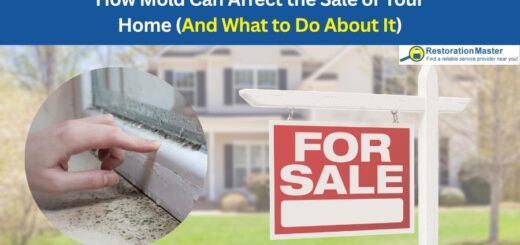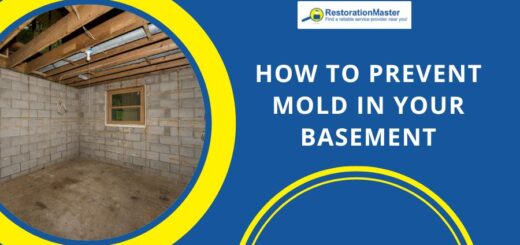Black Mold Removal: DIY or Hire a Pro?
Several species of moldMold is a type of fungus that grows in damp or humid conditi... More thrive in the environment. One especially harmful type of moldMold is a type of fungus that grows in damp or humid conditi... More is black moldMold is a type of fungus that grows in damp or humid conditi... More, formally known in the scientific community as Stacybotrys chartarum or StachybotrysStachybotrys is a type of black mold (often called “black ... More chlorohalonata. Black moldMold is a type of fungus that grows in damp or humid conditi... More is not as common as these indoor molds: Cladosporium, Penicillium, Aspergillus, and Alternaria; but it is hardly rare.
When a moldMold is a type of fungus that grows in damp or humid conditi... More infestation has found its way into the dark and damp recesses of your home, do you remove it yourself or hire a mold removal and remediation company to do the hard work? The most appropriate action depends on the severity of the moldMold is a type of fungus that grows in damp or humid conditi... More invasion. If the toxic moldMold is a type of fungus that grows in damp or humid conditi... More sporesSpores are microscopic reproductive units of fungi or mold t... More have clung to an area over ten square feet, then a mold remediationMold remediation is the process of identifying, removing, an... More and removal company is best suited to tackle the task. However, small moldMold is a type of fungus that grows in damp or humid conditi... More growth can be handled with a little elbow grease and determination.
Before you call a professional or grab the nearest spongeA sponge is a porous material used to absorb liquids or clea... More, there are a few things to know about the nature of moldMold is a type of fungus that grows in damp or humid conditi... More. Essentially, indoor moldMold is a type of fungus that grows in damp or humid conditi... More only grows where a constant supply of moisture is present—indoors, this is called water damage. MoldMold is a type of fungus that grows in damp or humid conditi... More sporesSpores are microscopic reproductive units of fungi or mold t... More feed on porousPorous describes a material that contains small openings or ... More surfaces, like drywall or fiberboard, when a water source is abundant. MoldMold is a type of fungus that grows in damp or humid conditi... More ceases to exist when moisture, and its nourishment, becomes nonexistent.
MoldMold is a type of fungus that grows in damp or humid conditi... More is found throughout nature, in both the great outdoors and the cozy indoors. It’s only when sporesSpores are microscopic reproductive units of fungi or mold t... More float through the air and land onto a moisture-rich area inside a home, through open windows, for instance, or heating or ventilationVentilation is the process of exchanging or circulating air ... More systems, outdoor air intakes or air conditioning units, that moldMold is a type of fungus that grows in damp or humid conditi... More poses as a health hazard to humans.
Occupants who live in a home where moldMold is a type of fungus that grows in damp or humid conditi... More sporesSpores are microscopic reproductive units of fungi or mold t... More have flourished are likely to experience ill health, including runny nose and eyes, coughs, itchy skin and respiratory conditions, like asthma. Fungal infections are also common in people with existing lung diseases or weakened immune systems.
Identify Black MoldMold is a type of fungus that grows in damp or humid conditi... More
 So how do you know if your home is affected by the unwanted houseguest known as black moldMold is a type of fungus that grows in damp or humid conditi... More? The fungus is easily spotted—and smelled. Black moldMold is a type of fungus that grows in damp or humid conditi... More is rarely disguised. Rather, large greenish-black splotches indicate the presence of black moldMold is a type of fungus that grows in damp or humid conditi... More. A strong, musty odorAn odor is a smell, often detectable by the human nose, whic... More is also a dead giveaway of black moldMold is a type of fungus that grows in damp or humid conditi... More. Plus, if allergy symptoms worsen only when inside your home, moldMold is a type of fungus that grows in damp or humid conditi... More may be the culprit.
So how do you know if your home is affected by the unwanted houseguest known as black moldMold is a type of fungus that grows in damp or humid conditi... More? The fungus is easily spotted—and smelled. Black moldMold is a type of fungus that grows in damp or humid conditi... More is rarely disguised. Rather, large greenish-black splotches indicate the presence of black moldMold is a type of fungus that grows in damp or humid conditi... More. A strong, musty odorAn odor is a smell, often detectable by the human nose, whic... More is also a dead giveaway of black moldMold is a type of fungus that grows in damp or humid conditi... More. Plus, if allergy symptoms worsen only when inside your home, moldMold is a type of fungus that grows in damp or humid conditi... More may be the culprit.
However, sometimes moldMold is a type of fungus that grows in damp or humid conditi... More can thrive in spaces most homeowners may not often frequent. A crawl space, attic or basement often harbors moldMold is a type of fungus that grows in damp or humid conditi... More, especially when water damage is present. Black moldMold is a type of fungus that grows in damp or humid conditi... More may even invade spaces behind wallpaper or underneath damp carpeting, places a typical homeowner may not suspect.
Danger of DIY Black MoldMold is a type of fungus that grows in damp or humid conditi... More Removal
As mentioned above, you should only consider DIY mold removal if the moldMold is a type of fungus that grows in damp or humid conditi... More covers an area that is smaller than 10 square feet. If the moldMold is a type of fungus that grows in damp or humid conditi... More in question is black moldMold is a type of fungus that grows in damp or humid conditi... More, then it is best to avoid DIY moldMold is a type of fungus that grows in damp or humid conditi... More removal methods and contact a professional. All moldMold is a type of fungus that grows in damp or humid conditi... More types can leadLead is a heavy metal that can be toxic to humans, especiall... More to the health issues discussed above, but black moldMold is a type of fungus that grows in damp or humid conditi... More is more dangerous and aggressive. Trying to remove black moldMold is a type of fungus that grows in damp or humid conditi... More yourself puts you and others in your home in danger of serious health effects.
In addition to the health risks, you should avoid DIY moldMold is a type of fungus that grows in damp or humid conditi... More removal because DIY methods are not nearly as effective as professional mold remediationMold remediation is the process of identifying, removing, an... More methods. Mold removal and remediation professionals have experience dealing with moldMold is a type of fungus that grows in damp or humid conditi... More issues, and they use proper equipment and proven methods to ensure that the moldMold is a type of fungus that grows in damp or humid conditi... More is completely removed.
The following scenarios are difficult and dangerous for DIY mold removal, especially if the mold is black mold:
- Large MoldMold is a type of fungus that grows in damp or humid conditi... More Infestations: If the moldMold is a type of fungus that grows in damp or humid conditi... More growth in your home covers a large area, it will more than likely require complex mold remediationMold remediation is the process of identifying, removing, an... More. Removing large amounts of moldMold is a type of fungus that grows in damp or humid conditi... More while preventing it from spreading is difficult without the proper equipment, and moldMold is a type of fungus that grows in damp or humid conditi... More covering a large area may also be in hard to clean places like behind walls. Even cleaning a small moldMold is a type of fungus that grows in damp or humid conditi... More outbreak can do more harm than good by causing the moldMold is a type of fungus that grows in damp or humid conditi... More to disperse its sporesSpores are microscopic reproductive units of fungi or mold t... More. A mold remediation service professional can effectively handle complex moldMold is a type of fungus that grows in damp or humid conditi... More removal, including in hidden areas, and keep the moldMold is a type of fungus that grows in damp or humid conditi... More growth contained.
- MoldMold is a type of fungus that grows in damp or humid conditi... More from FloodingFlooding is the overflow or accumulation of water in areas t... More: In home floodingFlooding is the overflow or accumulation of water in areas t... More often leads to moldMold is a type of fungus that grows in damp or humid conditi... More due to the excess moisture. Cleaning up the water does not mean that you are safe from moldMold is a type of fungus that grows in damp or humid conditi... More. MoldMold is a type of fungus that grows in damp or humid conditi... More growth can easily develop later and if the moldMold is a type of fungus that grows in damp or humid conditi... More, or the cause of the floodingFlooding is the overflow or accumulation of water in areas t... More, is not addressed, the problem will persist.
- MoldMold is a type of fungus that grows in damp or humid conditi... More in HVAC System: MoldMold is a type of fungus that grows in damp or humid conditi... More growth in your air ducts can be especially dangerous because it will spread the sporesSpores are microscopic reproductive units of fungi or mold t... More throughout your home, increasing the risk of negative health effects and the spread of the growth. You must call a professional that can effectively locate and remove moldMold is a type of fungus that grows in damp or humid conditi... More from the HVAC system.
- MoldMold is a type of fungus that grows in damp or humid conditi... More Growth on Wood: MoldMold is a type of fungus that grows in damp or humid conditi... More commonly affects wooden surfaces and objects because wood is porousPorous describes a material that contains small openings or ... More. It is possible to salvage wood affected by moldMold is a type of fungus that grows in damp or humid conditi... More, but it takes advanced techniques to do it. A moldMold is a type of fungus that grows in damp or humid conditi... More removal professional has the equipment to salvage wood surfaces and they can also tell if the moldMold is a type of fungus that grows in damp or humid conditi... More growth has penetrated these surfaces into spaces such as attics and crawlspaces.
Professional Mold RemediationMold remediation is the process of identifying, removing, an... More

Calling a professional moldMold is a type of fungus that grows in damp or humid conditi... More removal and remediation companyA remediation company is a business specializing in cleaning... More is the best and safest alternative to a DIY project. You avoid any chance of contaminating other areas of the home (which is likely to occur during a DIY cleanup process) when a professional is called in to tackle the challenge. Another advantage of contacting a professional is that moldMold is a type of fungus that grows in damp or humid conditi... More coverage may be included in your home insurance policy.
When you elect to hire a professional, RestorationMaster can be relied upon for a swift response to moldMold is a type of fungus that grows in damp or humid conditi... More growth.












